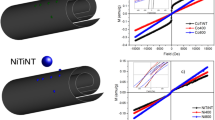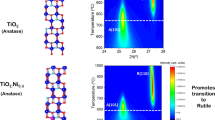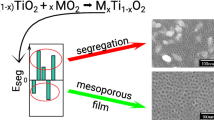Abstract
The positions of the upper edge of the valence band and the lower edge of the conduction band of semiconducting materials such as TiO2 are closely related to the values of the respective oxidation or reduction potentials. The modifications suffered by a material of this type impact on the displacements of the aforementioned bands and thus on the redox potentials. In the present work, anatase and rutile bulk systems are analyzed for how different metallic and nonmetallic dopants located substitutionally where the “@” symbol indicates that the preceding element replaces the element after it or interstitially this position in the network is indicated with the letter “i” affect these potentials. From the analysis of the modifications, consequence of the doping, it can be noted that substitutional doping of nitrogen (N) at the oxygen site (N@O) improves the reduction potential of anatase and doped with interstitial (Ni) that of rutile. On the other hand, for both polymorphs, interstitial iron (Fei) doping has the best oxidant properties, followed by doping with Fe in titanium (Ti) site (Fe@Ti). The latter also has interesting magnetic properties to facilitate the extraction of the titania from the reaction media. The other doping elements studied, vanadium, platinum, silver, carbon and fluorine only improve the oxidation potential but all to a lesser extent than iron.















Similar content being viewed by others
References
Kobwittaya, K., Sirivithayapakorn, S.: Photocatalytic reduction of nitrate over TiO2 and Ag-modified TiO2. J. Saudi Chem. Soc. 18, 291–298 (2014). https://doi.org/10.1016/j.jscs.2014.02.001
Zouzelka, R., Rathousky, J.: Photocatalytic abatement of NOx pollutants in the air using commercial functional coating with porous morphology. Appl. Catal. B Environ. 217, 466–476 (2017). https://doi.org/10.1016/j.apcatb.2017.06.009
Guan, X., Du, J., Meng, X., Sun, Y., Sun, B., Hu, Q.: Application of titanium dioxide in arsenic removal from water: a review. J. Hazard. Mater. 215–216, 1–16 (2012). https://doi.org/10.1016/j.jhazmat.2012.02.069
Kanakaraju, D., Glass, B.D., Oelgemöller, M.: Titanium dioxide photocatalysis for pharmaceutical wastewater treatment. Environ. Chem. Lett. 12, 27–47 (2014). https://doi.org/10.1007/s10311-013-0428-0
Kang, X., Liu, S., Dai, Z., He, Y., Song, X., Tan, Z.: Titanium dioxide: from engineering to applications. Catalysts 9, 191 (2019). https://doi.org/10.3390/catal9020191
Zhang, M., Chen, T., Wang, Y.: Insights into TiO2 polymorphs: highly selective synthesis, phase transition, and their polymorph-dependent properties. RSC Adv. 7, 52755–52761 (2017). https://doi.org/10.1039/c7ra11515f
Morgade, C.I.N., Cabeza, G.F.: First-principles study of codoping TiO2 systems capable of improving the specific surface area and the dissociation of H2O to generate H2 and O2. Comput. Mater. Sci. 127, 204–210 (2017). https://doi.org/10.1016/j.commatsci.2016.10.038
Pauling, L.: The principles determining the structure of complex ionic crystals. J. Am. Chem. Soc. 51, 1010–1026 (1929). https://doi.org/10.1021/ja01379a006
Born, M., Huang, K.: Dynamical Theory of Crystal Lattice. Oxford Classic Texts in the Physical Sciences (1954)
Ryu, J., Choi, W.: Substrate-specific photocatalytic activities of TiO2 and multiactivity test for water treatment application. Environ. Sci. Technol. 42, 294–300 (2008). https://doi.org/10.1021/es071470x
Schneider, J., Matsuoka, M., Takeuchi, M., Zhang, J., Horiuchi, Y., Anpo, M., Bahnemann, D.W.: Understanding TiO2 photocatalysis: mechanisms and Materials. Chem. Rev. 114, 9919–9986 (2014). https://doi.org/10.1021/cr5001892
Vorontsov, A.V., Kabachkov, E.N., Balikhin, I.L., Kurkin, E.N., Troitskii, V.N., Smirniotis, P.G.: Correlation of surface area with photocatalytic activity of TiO2. J. Adv. Oxid. Technol. 21, 127–137 (2018). https://doi.org/10.26802/jaots.2017.0063
Cheng, H., Wang, J., Zhao, Y., Han, X.: Effect of phase composition, morphology, and specific surface area on the photocatalytic activity of TiO2 nanomaterials. RSC Adv. 4, 47031–47038 (2014). https://doi.org/10.1039/c4ra05509h
Yan, H., Wang, X., Yao, M., Yao, X.: Band structure design of semiconductors for enhanced photocatalytic activity: the case of TiO2. Prog. Nat. Sci. Mater. Int. 23, 402–407 (2013). https://doi.org/10.1016/j.pnsc.2013.06.002
Morgade, C.I.N., Vignatti, C.I., Avila, M.S., Cabeza, G.F.: Theoretical and experimental analysis of the oxidation of CO on Pt catalysts supported on modified TiO2(101). J. Mol. Catal. A: Chem. 407, 102–112 (2015). https://doi.org/10.1016/j.molcata.2015.06.024
Morgade, C.I.N., Castellani, N.J., Cabeza, G.F.: Theoretical analysis of band alignment and charge carriers migration in mixed-phase TiO2 systems. J. Comput. Electron. 17, 1505–1514 (2018). https://doi.org/10.1007/s10825-018-1232-7
Humayun, M., Raziq, F., Khan, A., Luo, W.: Modification strategies of TiO2 for potential applications in photocatalysis: a critical review. Green Chem. Lett. Rev. 11, 86–102 (2018). https://doi.org/10.1080/17518253.2018.1440324
Kresse, G., Furthmüller, J.: Efficient iterative schemes for ab initio total-energy calculations using a plane-wave basis set. Phys. Rev. B - Condens. Matter Mater. Phys. 54, 11169–11186 (1996). https://doi.org/10.1103/physrevb.54.11169
Blöchl, P.E.: Projector augmented-wave method. Phys. Rev. B. 50, 17953–17979 (1994). https://doi.org/10.1103/PhysRevB.50.17953
Perdew, J.P., Wang, Y.: Accurate and simple density functional for the electronic exchange energy: generalized gradient approximation. Phys. Rev. B. 33, 8800–8802 (1986). https://doi.org/10.1103/PhysRevB.33.8800
Methfessel, M., Paxton, A.T.: High-precision sampling for Brillouin-zone integration in metals. Phys. Rev. B. 40, 3616–3621 (1989). https://doi.org/10.1103/PhysRevB.40.3616
Dudarev, S.L., Botton, G.A., Savrasov, S.Y., Humphreys, C.J., Sutton, A.P.: Electron-energy-loss spectra and the structural stability of nickel oxide: an LSDA + U study. Phys. Rev. B. 57, 1505–1509 (1998). https://doi.org/10.1103/PhysRevB.57.1505
Bader, R.F.W.: Atoms in Molecules—A Quantum Theory. Oxford University Press, Oxford (1990)
Momma, K., Izumi, F.: VESTA 3 for three-dimensional visualization of crystal, volumetric and morphology data. J. Appl. Crystallogr. 44, 1272–1276 (2011). https://doi.org/10.1107/S0021889811038970
Gomes, J., Lincho, J., Domingues, E., Quinta-Ferreira, R.M., Martins, R.C.: N-TiO2 photocatalysts: a review of their characteristics and capacity for emerging contaminants removal. Water (Switzerland) 11, 373 (2019). https://doi.org/10.3390/w11020373
Morgade, C.I.N., Cabeza, G.F.: Synergetic interplay between metal (Pt) and nonmetal (C) species in codoped TiO2: a DFT + U study. Comput. Mater. Sci. 111, 513–524 (2016). https://doi.org/10.1016/j.commatsci.2015.09.065
Dozzi, M.V., D’Andrea, C., Ohtani, B., Valentini, G., Selli, E.: Fluorine-doped TiO2 materials: photocatalytic activity vs time-resolved photoluminescence. J. Phys. Chem. C 117, 25586–25595 (2013). https://doi.org/10.1021/jp4095563
Zhou, W., Liu, Q., Zhu, Z., Zhang, J.: Preparation and properties of vanadium-doped TiO2 photocatalysts. J. Phys. D Appl. Phys. 43, 2–7 (2010). https://doi.org/10.1088/0022-3727/43/3/035301
Hu, Y., Song, X., Jiang, S., Wei, C.: Enhanced photocatalytic activity of Pt-doped TiO2 for NOx oxidation both under UV and visible light irradiation: a synergistic effect of lattice Pt4+ and surface PtO. Chem. Eng. J. 274, 102–112 (2015). https://doi.org/10.1016/j.cej.2015.03.135
Schvval, A.B., Juan, A., Cabeza, G.F.: Theoretical study of the role of the interface of Ag4 nanoclusters deposited on TiO2(110) and TiO2(101). Appl. Surf. Sci. (2019). https://doi.org/10.1016/j.apsusc.2019.05.291
Ghorbanpour, M., Atabak, F.: Iron-doped TiO2 catalysts with photocatalytic activity. J. Water Environ. Nanotechnol. 4, 60–66 (2019). https://doi.org/10.22090/jwent.2019.01.006
Buckeridge, J., Butler, K.T., Catlow, C.R.A., Logsdail, A.J., Scanlon, D.O., Shevlin, S.A., Woodley, S.M., Sokol, A.A., Walsh, A.: Polymorph engineering of TiO2: demonstrating how absolute reference potentials are determined by local coordination. Chem. Mater. 27, 3844–3851 (2015). https://doi.org/10.1021/acs.chemmater.5b00230
Lee, J., Kim, J., Choi, W.: TiO2 photocatalysis for the redox conversion. Aquat. Redox Chem. Ch. 10, 15–20 (2011). https://doi.org/10.1021/bk-2011-1071.ch010
Kyung, H., Lee, J., Choi, W.: Simultaneous and synergistic conversion of dyes and heavy metal ions in aqueous TiO2 suspensions under visible-light illumination. Environ. Sci. Technol. 39, 2376–2382 (2005). https://doi.org/10.1021/es0492788
Bard, A.J., Parsons, R., Jordan, J.: Standard Potentials in Aqueous Solution. Taylor & Francis, London (1985)
Di Valentin, C., Finazzi, E., Pacchioni, G., Selloni, A., Livraghi, S., Paganini, M.C., Giamello, E.: N-doped TiO2: theory and experiment. Chem. Phys. 339, 44–56 (2007). https://doi.org/10.1016/j.chemphys.2007.07.020
McCaldin, J.O., McGill, T.C., Mead, C.A.: Correlation anion. Electronegativity 61, 1249–1252 (1975). https://doi.org/10.1097/BRS.0b013e3181cddbbf
Harrison, W.A., Tersonff, J.: Tight-binding theory of heterojunction band lineups and interface dipoles. J. Vac. Sci. Technol. B Microelectron. Nanom. Struct. 4, 1068 (1986). https://doi.org/10.1116/1.583544
Klein, A.: Energy band alignment at interfaces of semiconducting oxides: a review of experimental determination using photoelectron spectroscopy and comparison with theoretical predictions by the electron affinity rule, charge neutrality levels, and the common anion rule. Thin Solid Films 520, 3721–3728 (2012). https://doi.org/10.1016/j.tsf.2011.10.055
Acknowledgements
The authors thank the financial support from the Consejo Nacional de Investigaciones Científicas y Técnicas (CONICET) and the Universidad Nacional del Sur (UNS) (PGI: 24/F068). Universidad Tecnológica Nacional, Facultad Regional Bahía Blanca (UTN-FRBB).
Author information
Authors and Affiliations
Corresponding author
Additional information
Publisher's Note
Springer Nature remains neutral with regard to jurisdictional claims in published maps and institutional affiliations.
Electronic supplementary material
Below is the link to the electronic supplementary material.
Rights and permissions
About this article
Cite this article
Schvval, A.B., Jiménez, M.J., Fuente, S. et al. Theoretical study of the modification of the oxide-reducing capacity of titania from selected dopant elements. J Comput Electron 19, 493–506 (2020). https://doi.org/10.1007/s10825-020-01454-0
Published:
Issue Date:
DOI: https://doi.org/10.1007/s10825-020-01454-0




